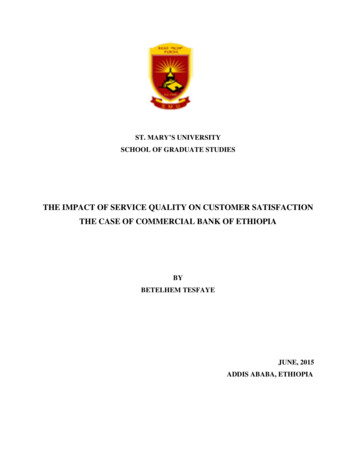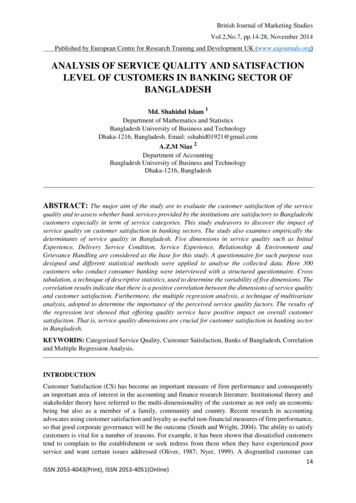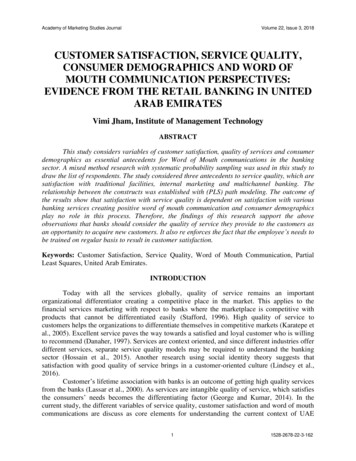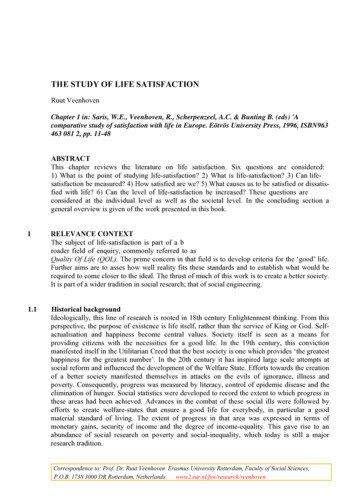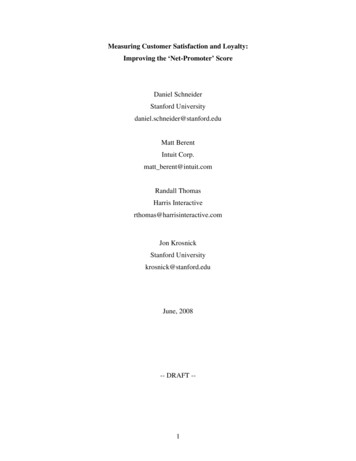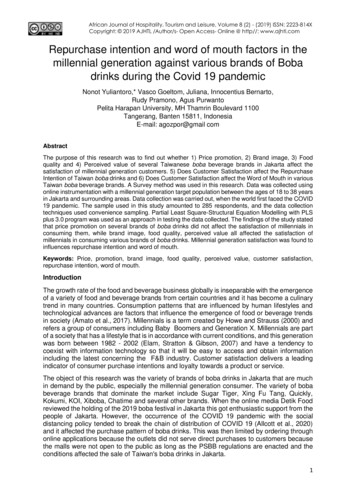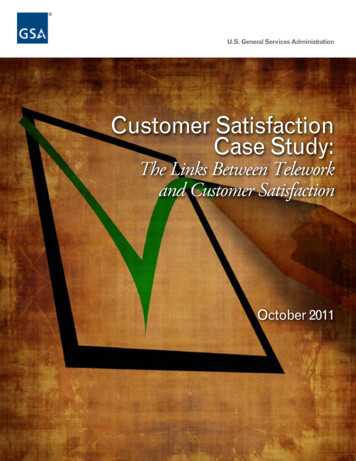
Transcription
U.S. General Services AdministrationCustomer SatisfactionCase Study:The Links Between Teleworkand Customer SatisfactionOctober 20111
U.S. General Services AdministrationCustomer SatisfactionCase Study:The Links Between Teleworkand Customer SatisfactionOctober 20112
Customer Satisfaction Case Study: The Links between Telework and Customer SatisfactionIntroductionWith the continuing increase in telework, theways in which employees connect with internaland external customers is changing. Followinginquiries and feedback from other federalagencies and organizations, GSA’s TeleworkProgram Management Office (PMO) setout to understand and increase awarenessof the links between telework and customersatisfaction.Three questions GSA’s partner organizationshave commonly asked are:from this qualitative data study are from anemployee perspective only; the PMO did notpoll customers for their views. Additionally,the PMO did not include control groups,which could limit the study’s findings.Second, the agency PMO reviewedquantitative data derived from work-groupinterviews. Quantitative data is being collectedon an ongoing basis from various customersatisfaction surveys and will be reported in acompanion paper.A small team was formed to develop interviewquestions (listed in Appendix 1) and meetwith the five GSA work group members whointeract directly with external customers. Theinterviews were designed to:1. What best practices result incustomer satisfaction?2. What challenges do mobile workersface in giving excellent customerservice? Surface best practices fordeveloping customer satisfactionwhile teleworking3. What benefits does mobile workingbring to the agent, the customer,and to the organization? Identify any customer satisfactionchallenges encountered Solicit the perceived pros and consof telework as it relates to customersatisfaction.ApproachThe interviews were conducted over the phoneand took approximately a half-hour each.One to three people conducted the interviews,taking turns to facilitate and take notes.In an effort to find answers to these threequestions GSA took a two-pronged approach.First the agency PMO looked at qualitativedata obtained from five work groups thatindicated on the GSA Mobile Work Forumthat they were enabled by telework to betterserve their customers. The conclusions drawn3
Customer Satisfaction Case Study: The Links between Telework and Customer SatisfactionFindingsindicate on voicemail or an emailout of office notice that they areteleworking.1. There are distinct best practices forimproving customer satisfaction whileteleworking that benefit organizations. Develop uniform customer servicestandards. Establish clear performanceexpectations, goals, range ofemployee flexibility, and limits ofaccountability. Plan mobile work carefully. Use acalendar and task lists to keep trackof meetings and tasks. Train employees and managers onhow to provide excellent customerservice in a telework environment. Baseline current customersatisfaction measures as a meansto gauge improvement in futureyears. Ensure management support andencouragement of teleworking Share best practices and lessonslearned within the organization oncustomer service while in a mobilework environment. Provide the right tools for eachemployee to do his or her job as amobile worker. Establish links between employeesatisfaction (e.g. Q12 surveys)and existing customer satisfactionsurveys as a means to identifysuccessful mobile workingpractices. Take advantage of thelatest technologies thatfacilitate communication andresponsiveness with customers,including instant messaging,Google features (Calendar,Documents, Sites, Voice), andonline multi-party meetings.2. There are consistent challengesfaced by teleworking employees as theysupport high levels of customer service. Obtain feedback from employeesvoicing concerns about telework, asit can provide useful improvementinformation. There is a perceived lack ofmanager support for mobile work There is a concern amongmanagers that employees will bemore easily distracted workingin a less formal environment andless focused due to multitasking.This challenge is coupled with aconcern arising from the inabilityof managers to physically see theiremployees doing work.“Telework is seamless to our customers.They are not aware if we are in theoffice or at home when we communicatewith them” There should be no difference inthe level of support provided to acustomer if an employee is in theoffice or working remotely. For thisreason do not allow employees to An inconsistent digitization offiles negatively impacts customerservice, when employees are not4
Customer Satisfaction Case Study: The Links between Telework and Customer SatisfactionEmployee Benefitsable to access everything that acustomer needs, while they areworking in a remote location. Flexibility in employee workscheduling affords enhancedcustomer service and greateraccountability. Issues with some of thetechnological aspects of workingremotely hinder customer service. An improved work-life balanceincreases employee morale, whichin turn generally leads to enhancedcustomer service.3. There are stakeholder benefits ofteleworking that promote customersatisfaction. Employees in the surveyedwork groups are measured onproductivity and outcomes, and notthe number of hours spent in theoffice.Customers Benefits Working from alternate locationsgenerally means fewer interruptionsfor employees, resulting in theirability to provide customers withtheir undivided attention.Organization Benefits The organizations recognize theexpanded ability to use technologyto communicate and respond tocustomers in a timely manner.“With telework there are no disruptionswhen talking with customers so you cangive them your undivided attention.” The process of ContinuedOperations, or COOP, allowsfor no loss of time due toinclement weather or other typesof emergencies. Customers donot experience a break in servicebecause of telework and COOPmeasures, even if a GSA buildingis closed for the day. Technology use enhances thecustomers’ experience; for example,the use of online multi-partymeetings allows multiple people toconnect remotely.“Technology is used to enhance thecustomer experience and improveproductivity since employees are moreavailable.”“With telework, we were fullyoperational the week the buildings wereclosed due to the inclement weather” Telework allows for increasedproductivity and customer service.5
Customer Satisfaction Case Study: The Links between Telework and Customer Satisfaction Communication and trainingwill put employees in a positionto continue to provide excellentservice to the customer. Sick leave usage declines sincetelework allows employees theflexibility to schedule medicalappointments on telework days,and then return to finish the workday rather than having to schedulethe whole day as out of office. Several organizations, includingGSA, have realized real estatesavings due to reduced space andenergy needs. GSA is viewed asthe government leader and canshare these best practices withother agencies. Clear expectations andaccountability keep employeeson track, while goals andmeasurements keep anorganization on track.“The voicemail that says,“I’m teleworkingtoday” shouldn’t happen.” The environment should be resultsoriented, based on customerexpectations rather than a dutyhour schedule. Telework and reduced commutertravel will help agencies meet theirScope 3 greenhouse gas (GHG)emissions reductions requirementsunder Executive Order 13514. While teleworking has somechallenges, its benefits foremployee customer andorganization outweigh thosechallenges.Conclusion Being a successful teleworker is nodifferent than being successful atany other business initiative. Thatis, management support is a key tosuccess.“From the customer’s standpoint, itshouldn’t matter if you are teleworking.It needs to be a seamless experience,embedded into well managed operations.”6
Customer Satisfaction Case Study: The Links between Telework and Customer SatisfactionAppendix 1:Interview questions7. With mobile work, how do you interactnow with your customers? What toolsand/or technology do you use tofacilitate communication?The following questions were asked:8. What are the two or three biggestchallenges you still face working in amobile work environment that youdidn’t face in a traditional office settingand what steps are you taking toovercome them?1. Please tell us more about yourexperience as indicated on the mobilework forum.2. How often do you and your teammobile work?9. Do your customers know you mobilework? If so, how?3. Please describe how your team mobileworks. What are the alternative worklocations?10. What type of feedback have youreceived from your customers abouthow you interact with them?4. Who are your customers?5. Prior to mobile work, how did youinteract or communicate with yourcustomers?11. What are your most successful bestpractices?12. Anything else that you would liketo mention?6. What encouraged your move to amobile work environment?7
Smarter Solutions8
customer service while in a mobile work environment. Establishlinks betweenemployee satisfaction(e.g. Q12 surveys) and existing customer satisfaction surveysas a means to identify successful mobile working practices. 2. There are consistent challenges faced by teleworking employees as they support high levels of customer service.


